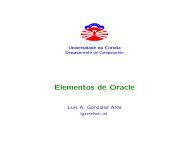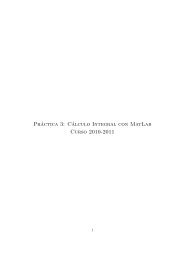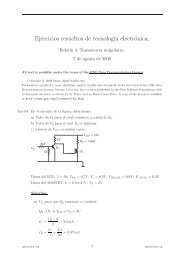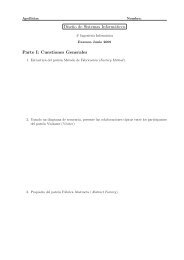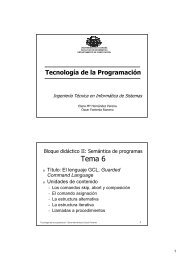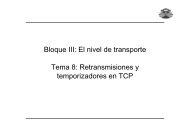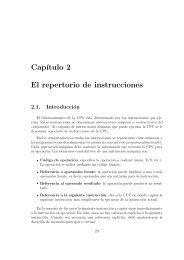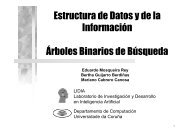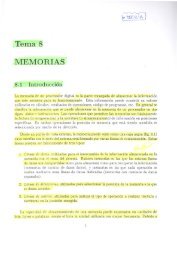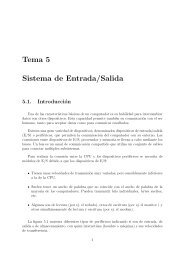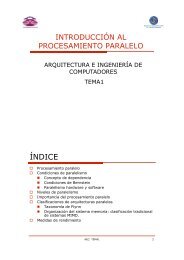Ejercicios resueltos de Matemática discreta ... - QueGrande
Ejercicios resueltos de Matemática discreta ... - QueGrande
Ejercicios resueltos de Matemática discreta ... - QueGrande
- No tags were found...
You also want an ePaper? Increase the reach of your titles
YUMPU automatically turns print PDFs into web optimized ePapers that Google loves.
<strong>Ejercicios</strong> <strong>resueltos</strong> <strong>de</strong> funciones generatrices. Matemática <strong>discreta</strong> 4º Ingeniería Informática<br />
c) Obviamente es el caso b para a=1+a, es <strong>de</strong>cir<br />
1<br />
1−<br />
(1 + a)x<br />
d) f(x) = 2+(1+a)x+(1+a 2 )x 2 + ... = (1+x+x 2 +...)+(1+ax+a 2 x 2 +...)<br />
1 1<br />
f ( x)<br />
= +<br />
1−<br />
x 1−<br />
ax<br />
41) Sea C = { a,<br />
b,<br />
c,<br />
d,<br />
e,<br />
f , g}<br />
a) Hállese la función generatriz para los subconjuntos <strong>de</strong> C. ¿Cuántos sumandos hay<br />
en los coeficientes x 2 <strong>de</strong> esta función<br />
b) Hállese la función generatriz para la forma <strong>de</strong> seleccionar n objetos <strong>de</strong> C con<br />
0≤n≤14, <strong>de</strong> C, don<strong>de</strong> cada objeto pue<strong>de</strong> seleccionarse a lo sumo dos veces. ¿Cuántos<br />
sumandos hay en el coeficiente x 2 <strong>de</strong> esta función<br />
SOLUCIÓN:<br />
a) La forma <strong>de</strong> elección <strong>de</strong> cada objeto es 1+x (no lo tomo o lo tomo en el<br />
subconjunto). Como son 7 objetos, la función generatriz es (1+x) 7 y el coeficiente <strong>de</strong> x 2<br />
⎛7 ⎞<br />
es ⎜ ⎟ = 21<br />
⎝2⎠<br />
b) La selección <strong>de</strong> cada objeto es ahora 1+x+x 2<br />
La función generatriz es (1+x+x 2 ) 14 . La solución sería el coeficiente <strong>de</strong> x n<br />
El coeficiente <strong>de</strong> x 2 :<br />
Vamos a ver la función asociada a 1+x+x 2<br />
Sabemos que 1/(1-x) = 1+x+x 2 +...<br />
-x 3 /(1-x) = -x 3 -x 4 -...<br />
Sumando ambas funciones resulta que 1+x+x 2 = (1-x 3 )/(1-x)<br />
Por tanto la solución buscada es el coeficiente <strong>de</strong> x 2 en (1-x 3 ) 14 (1-x) -14<br />
⎛−14⎞<br />
⎛15⎞<br />
que es ⎜ ⎟ = ⎜ ⎟ = 105<br />
⎝ 2 ⎠ ⎝ 2 ⎠<br />
42.) Hállese el coeficiente <strong>de</strong> x 83 en f(x) = (x 5 + x 8 + x 11 + x 14 + x 17 ) 10<br />
x 5 + x 8 + x 11 + x 14 + x 17 = x 5 (1 + x 3 + x 6 + x 9 + x 12 )<br />
Por otra parte si g(x) = 1 + x 3 + x 6 + x 9 + x 12 + ...<br />
Multiplicando por –x 3 se obtiene que –x 3 g(x) = -x 3 –x 6 - ... Sumando ambos tenemos<br />
que g(x) = 1/(1-x 3 ). Si multiplico por –x 15 obtengo –x 15 –x 18 – x 21 - ... por tanto tenemos<br />
que 1 + x 3 + x 6 + x 9 + x 12 = (1-x 15 )/(1-x 3 )<br />
La solución que busco es el coeficiente <strong>de</strong> grado 33 en (1-x 15 ) 10 .(1-x 3 ) -10<br />
José M. Ramos González 44




